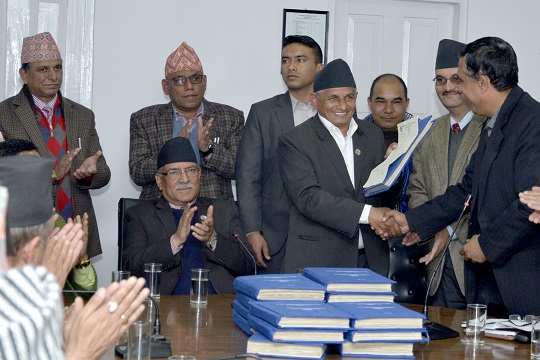New local federal structure (Commentary)
 Manoj Karki / Kathmandu: The lowest level of the governance unit in a federal structure is regarded as one of the most important tiers of governance. As the tier is right at the grassroots its effectiveness will ensure the success of the federal structure usually adopted to replace an existing form of governance.
Manoj Karki / Kathmandu: The lowest level of the governance unit in a federal structure is regarded as one of the most important tiers of governance. As the tier is right at the grassroots its effectiveness will ensure the success of the federal structure usually adopted to replace an existing form of governance.
Nepal too joined the increasing list of federal states, with the adoption of a federal structure of governance envisaged in the new Constitution of Nepal adopted by the first ever Constituent Assembly of the country in 2015.
For Nepal, the local body is more so important because it was largely due to the highly centralized rule in the past including in the post-1990 democratic era that the demand for federalism got materialized. People felt the need to have their state machinery right at their doorstep, and not need to travel all the way to Kathmandu for each and every thing. Further, people wanted to develop themselves and their area in the way they like and not on the basis of the people who sit in the urban centres and decide on their behalf.
In this context, the report by the Local Bodies Restructuring Commission submitted to the government on Friday is one step towards realizing people’s long-held dream of a governance of their own, and in real terms. The LBRC has recommended dividing the country into 719 local bodies including four metropolis, 12 sub-metropolis, 241 municipalities and 462 village municipalities or gaon palika.
Unlike the proposed federal units, which is still a major bone of contention and the major content of the constitution amendment proposal registered in the parliament, the proposed local bodies is expected to be widely accepted. This is also because majority of the units in the districts were agreed upon locally, with the help of the local technical assistance committees that came with the numbers. However, few districts in some of the Madhesh districts could not hold deliberations on the proposed units and it had to be decided at the centre, with representation of the stakeholders including political parties. The LBRC has also claimed to have discussed with more than 50,000 stakeholders in course of finalizing the report that also uses the geographical information system or GIS.
In the second phase of its work, the LBRC will look into the constitutional provision of creating special, protected and autonomous regions within the local bodies. That will then give a final picture of the local tier of governance in the country. And the local bodies will finally come into effect with the endorsement of the report by the Council of Ministers and its publication in the Nepal gazette.
The coming into being of the local tiers of the government is also a significant step towards implementing the new constitution, which is currently being contested for and against amending it. It may be noted that the Government is preparing to table the constitution amendment proposal before the parliament in the coming meeting scheduled for Sunday.
The finalization and submission of the report now also lays to rest the debate over whether to go for local elections in the existing structure or the new federal structure. With the local bodies’ structure now decided, there is no need to be going back to the existing structure to hold local elections.
Holding local tier elections would probably be only the best option to deal with the current political crisis with the registration of the constitution amendment proposal in the parliament. It will also give the opportunity for the political parties to test themselves in the new federal set up and then gear up for the provincial and the federal or general elections. As elections of all the three tiers are to be held by January 2018, the outcome of the LBRC could kick start the process and ensure that there is no constitutional crisis for failure to hold all the three elections by then.
Timely elections at the lowest level of the governance structure could also give people the feeling of federalism, currently limited only to paper. People will get used to the new structure right from the grassroots level and probably meet their expectations to get services from the state right at their doorsteps, and run their state of affairs by themselves.
May be the LBRC report and the likelihood for timely local elections also gives the political parties an opportunity to reflect on the agreement they made to take the country the federal way ahead, and act accordingly to now focus on taking the nation towards the much-needed path to economic prosperity. RSS
